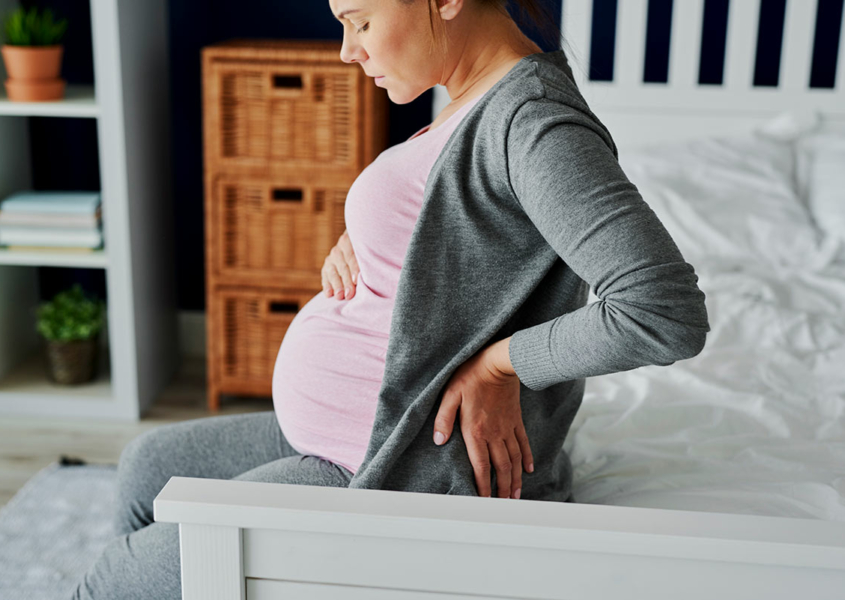Lower Back Pain During Pregnancy: Tips for Prevention and Relief
If you are experiencing upper or lower back pain during pregnancy, you’re not alone. In fact, up to 90% of pregnant women experience back pain at some point in their pregnancy. This can be frustrating, especially during an already physically demanding time in your life.
Fortunately, there are plenty of things you can do to help relieve and prevent lower back pain during pregnancy. Let’s take a look at what causes back pain during pregnancy, how to treat it, and when it could be a sign of something more serious.
Causes of Back Pain During Pregnancy
During the first trimester, your uterus is rapidly growing and changing. Even though your uterus is still relatively small, the growth is rapid, and your pelvic floor muscles must compensate.
In the third trimester, your uterus and baby are much larger and heavier. The redistribution of their weight changes your center of gravity and increases lordosis (the natural curvature of the spine). This can put more pressure on your vertebrae, which results in lower back pain.
Upper back pain during pregnancy is not as common, but can still happen due to changes in your center of gravity and the expansion of your rib cage. Yes, that’s right — your rib cage expands about an inch during pregnancy to accommodate your uterus and increased lung capacity.
Tips to Avoid Back Pain Before and During Pregnancy
Before You’re Pregnant
While some aches and pains during pregnancy are unavoidable as your body is changing to accommodate your growing baby, there are things you can do leading up to pregnancy that can help minimize discomfort. In your pre-pregnancy appointment, your OBGYN can discuss some methods to strengthen your core and pelvic floor before pregnancy.
The following exercises can help reduce the risk of back pain by preparing your body for the changes that come with pregnancy:
- Pelvic Tilts: This exercise helps to strengthen the pelvic muscles and can be done in a lying or standing position. Simply tilt your pelvis up and down, holding each position for a few seconds.
- Kegels: Kegel exercises can be done anywhere, making them a convenient way to strengthen the pelvic floor muscles. Simply contract the muscles you would use to stop urination and hold for a few seconds before releasing.
- Planks: Planks build strength in the core, including the pelvic floor muscles. Start with a shorter hold time, and gradually increase the duration as you become stronger.
- Yoga: Certain yoga poses, such as downward-facing dog and cat-cow, can help to stretch and strengthen the pelvic floor and core muscles.
During Pregnancy
If you already exercised before becoming pregnant, continue to do so during your pregnancy. If exercise was not part of your regular routine, consider adding low-impact exercises, such as stretching, yoga, swimming, Pilates, and Barre.
In the second and third trimesters, a maternity belt can provide additional support by holding your uterus closer to your body.
Be Careful Lifting When You’re Pregnant
Pregnant or not, lifting heavy objects without using good form can cause back pain by straining your muscles or putting pressure on your vertebrae. But it’s especially important when you’re pregnant to use proper form when you’re lifting anything heavy.
If you need to lift anything heavier than 20 lbs, make sure to engage your pelvic floor and core muscles and bend at the knees. Make sure your shoulders are over your hips with your hips tilted slightly forward.
Sleeping Positions to Relieve Back Pain During Pregnancy
Sleeping can be a source of discomfort for many women during pregnancy. To help relieve back pain, sleep on your side and use pregnancy pillows to support your knees and legs. Sleeping in this position can help your pelvis to maintain proper alignment. In the third trimester, try sleeping on your side with a body pillow under your stomach for added support.
Treatments
Most back pain during pregnancy is musculoskeletal in nature. It can be treated with supportive measures like heat or ice, and Tylenol for acute pain. Massage, physical therapy, and chiropractic care can also help alleviate back pain.
Can’t get in to see a massage therapist? Here is a DIY approach: Put two tennis balls in a tube sock. Roll your back up and down the tennis balls. You can do this standing up against a wall or on the floor. This will massage the muscles on either side of your vertebrae.
If you have a fever in addition to back pain, it’s best to reach out to your doctor. They may want to check for a UTI (urinary tract infection), which is more common in pregnant women.
Conclusion
Back pain during pregnancy is common but treatable. With the right steps, you can help relieve and even prevent back pain during this special time in your life. If you have any concerns or questions, don’t hesitate to reach out to your OBGYN. We’re here to support you and help you have a healthy pregnancy — and help you make this time as comfortable as possible.
 Dr. Isabel Nellen is excited to join Madison Women’s Health in the spring of 2022. She has been practicing full scope obstetrics and gynecology in the Milwaukee area since 2016 and looks forward to providing care to women in Madison. She specializes in obstetrics, preconception counseling, fertility evaluation, contraception, and management of abnormal uterine bleeding.
Dr. Isabel Nellen is excited to join Madison Women’s Health in the spring of 2022. She has been practicing full scope obstetrics and gynecology in the Milwaukee area since 2016 and looks forward to providing care to women in Madison. She specializes in obstetrics, preconception counseling, fertility evaluation, contraception, and management of abnormal uterine bleeding.







